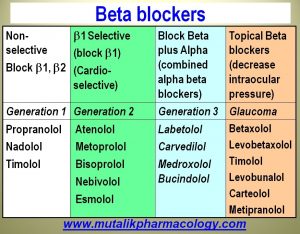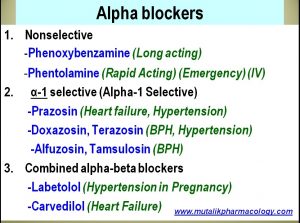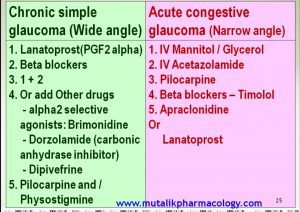Adrenergic Blockers
The two main adrenergic receptors are Alpha and Beta.
Adrenergic blockers means those who will be able to block only beta receptors / only alpha receptors / or both alpha and beta receptors.
Beta blockers are useful for various important cardiovascular conditions, anxiety related conditions, and also migraine and glaucoma.
Alpha blockers have a great value in relieving the symptoms of Benign Prostatic Hyperplasia (BPH). Some of them are also useful in cardiovascular conditions.
Some adrenergic blockers block Alpha as well as Beta receptors. (Combined Alpha-Beta Blockers). Traditionally, they are mentioned and classified as Beta Blockers of 3rd Generation. But when the question is asked as Alpha blockers, they may be mentioned as a class that Block Alpha receptors and also Beta receptors !!!
SAQ/LAQ/Viva
Classify adrenergic blockers with examples.
(A) BETA BLOCKERS

Another class of Beta blockers with less significance are – “Beta blockers with Intrinsic Sympathomimetic Activity (ISA)”. Examples: Acebutalol, Pindolol, Penbutolol.
(B) ALPHA BLOCKERS

SAQ/LAQ/Viva
Mention the therapeutic uses of beta blockers.
There is a way to remember uses of beta blockers.
Remember that they block beta receptors and decrease all the parameters related to heart including force, cardiac output, rate, oxygen consumption, and conductivity as well as blood pressure. So remember 5 cardiovascular conditions – hypertension, angina prophylaxis, prophylaxis of myocardial infarction, acute myocardial infarction, and arrhythmia (supraventricular tachycardia).
Then come to the symptoms of sympathetic overactivity and anxiety – thus start with thyrotoxicosis and then remember – anxiety states, alcohol withdrawal and drug withdrawal states, essential tremors and familial tremors.
Then don’t miss 2 important conditions – Chronic simple glaucoma and Migraine prophylaxis.
Beta Blockers : Therapeutic uses
1. Hypertension: They decrease the blood pressure by 3 mechanisms. – Decreasing cardiac output – Decreasing plasma renin activity – Central action: Decreasing the sympathetic outflow from the central nervous system.
2. Angina pectoris- chronic prophylaxis: Preventing the attacks of angina pectoris by decreasing the oxygen demand of the heart
3. Chronic Prevention of Myocardial infarction: Minimizing the severity and frequency of an attack of myocardial infarction
4. Acute Myocardial infarction: (MI): In an acute setup, they are useful in decreasing the sympathetic effects.
For use No 2, 3, and 4, the following actions help:
-They help in decreasing the frequency and severity of anginal attacks and further chances of myocardial infarction
-Decrease the cardiac output and the heart rate
-Decrease the oxygen consumption and work load of the heart
-Increase the exercise tolerance
-Help for redistribution of blood flow to ischemic areas
-Decrease the sympathetic overactivity in response to exercise, stress, and anxiety related causes.
5. Cardiac Arrhythmias (SVT): Useful in Supra Ventricular Tachycardias. Beta blockers decrease the conduction, the effect being predominant in SA node, atrium, and AV node. Esmolol is rapid acting agent useed intravenously in intraoperative/postoperative/Post – MI/ supraventricular arrhythmias. Helpful to prevent sudden death after MI or cardiac catheterization. Useful in atrial fibrillation and flutter, A-V nodal reentrant tachycardias, and catecholamine-induced arrhythmias, digitalis-induced tachycardia.
6. Thyrotoxicosis: Decrease the symptoms of thyrotoxicosis such as palpitation, tremors, and sweating. They decrease the heart rate, blood pressure, and prevent tachycardia and cardiac arrhythmias. They do not have effect on thyroid gland function. (However, they inhibit the peripheral conversion of T4 into T3 to some extent, which helps).
7. Anxiety states: Beta blockers are useful in various anxiety related conditions – Generalized Anxiety Disorder (GAD), Post-Traumatic Stress Disorder (PTSD), Phobia, Panic attacks, Stage fright etc. They relieve the manifestations of anxiety. They control the tachycardia, palpitation, sweating, and tremors.
8. Alcohol withdrawal state: They are useful to relieve the anxiety and its physical manifestations associated with alcohol withdrawal.
9. Drug withdrawal states: Similarly, they control the anxiety and its associated symptoms in the conditions of drug withdrawal.
10. Essential tremors / Familial tremors
11. Glaucoma: Betaxolol, Timolol, Carteolol, Levobunolol, Levobetaxolol – used topically. Decrease IOP (intraocular pressure) mainly by decreasing aqueous humor secretion. Useful especially in chronic simple glaucoma. [Advantages as compared to other agents: Less expensive, less adverse effects, easy availability].
13. Migraine (chronic): Useful in prevention of migraine. Blocks catecholamine induced vasodilation in the cerebral vasculature.
14. To decrease portal venous pressure and to prevent bleeding and death in patients with liver cirrhosis and esophageal varices. Examples: propranolol, nadolol
LAQ/SAQ/Viva
Mention adverse effects of beta blockers.
- Bradycardia: Decreased heart rate due to Beta-1 receptor blockade
- Hypotension: Decreased blood pressure by decreasing the cardiac output, renin activity as well as the central sympathetic outflow.
- Heart block: Due to Decreased AV conduction
- Breathlessness and bronchospasm due to blockade of the Beta-2 receptors in the bronchial smooth muscle. This may be especially precipitated in the patients having chronic obstructive pulmonary disease (COPD) – (Bronchial asthma, chronic bronchitis, emphysema, bronchiactesis etc)
- Hypoglycemia unresponsiveness: Because the beta-2 receptors in the liver are blocked, there is inhibition of glycogenolysis in situations of hypoglycemia, and blockade of glucagon release; hence the normal mechanism of correction of hypoglycmia is blocked. In addition to this, because the Beta-1 receptor is blocked, the response to hypoglycemia (tachycardia, palpitation, tremors, sweating) is absent. This is very dangerous because the patient may have severe hypoglycemia, but there is no symptom. This is especially so in the patients with diabetes mellitus, as these patients are prone to go into hypoglycemia.
- Rebound phenomena on abrupt stoppage of beta blockers after long-term use: Severe angina or hypertension may get precipitated if beta blockers are stopped abruptly. [Long-term use of antagonist drugs like beta blockers leads to up-regulation of the beta receptors because the blockers do not use the receptor. Due to the abrupt stoppage, there is supersensitivity of the receptors due to their stimulation by catechol-amines. So there may be sudden increase in heart rate, blood pressure, and work load on the heart, which may manifest as an attack of angina or sudden rise in blood pressure]
- Mental depression: Central as well as peripheral effects
- Weakness, fatigue, dizziness, drowsiness: Central as well as peripheral effects
- Sexual dysfuntion: Mostly in the form of erectile dysfunction
- Dyslipidemia: Mainly increase in TGs (Triglycerides) and VLDL, and decrease in HDL
- Sleep disturbances: Insomnia, vivid dreams, nightmares (Central effect)
- Cold extremities and dryness: Cold hands and feet, and dryness of mouth, skin, eyes
- Diarrhea or constipation: Central as well as peripheral effect.
- Ventricular dilation due to decreased contractility.
SAQ/Viva
Mention adverse effects of alpha blockers.
Vasodilation and smooth muscle relaxation are the key words to remember the adverse effects of alpha blockers.
Due to vasodilation –
- Hypotension (fall in blood pressure)
- First-dose effect: If a large first dose of a drug like prazosin is administered, and if the patient walks, then because alpha receptors are blocked by prazosin, the vasoconstriction is blocked, and there is no maintenance of blood pressure [Blocking of baroreflex response]. In this situation, the blood pressure falls and the patient may suffer from syncope (fainting). This is called first-dose effect. The first dose of prazosin must be small, and must be administered at bedtime, and the patient needs to be instructed not to change the posture suddenly.
- Postural hypotension/Orthostatic hypotension (Dizziness, syncope, fainting) (Increased venous capacitance, peripheral pooling of blood, decreased venous return) [Blocking of baroreflex response]
- Reflex tachycardia, palpitation, increased work load, precipitation of angina
- Throbbing headache due to vasodilation
- Flushing, redness, and warmth of the skin
- Miosis (constriction of pupil) and blurring of vision (blockade of alpha-1 adrenergic receptor in radial muscle of iris)
- Nasal congestion (constriction of smaller nasal blood vessels – Alpha-1 receptor blockade)
- Failure of ejaculation (Alpha-1 receptor in the male sex organ is blocked)
SAQ/Viva
Write a note on cardioselective Beta blockers (Beta-1 selective blockers), mentioning their examples and advantages.
Cardioselective beta blockers means the Beta blockers which selectively on the Beta-1 receptors and have a minimal action on Beta-2 receptors.
Examples; Atenolol, Metoprolol, Bisoprolol, Esmolol
These drugs have less effect on the Beta-2 receptors. So they have minimal effects on the sites having Beta-2 receptors; mainly – liver and bronchial smooth muscle,
Hence cardioselective or the Beta-1 selective blockers are less likely to produce hypoglycemia unresponsiveness, and also are less likely to precipitate bronchospasm.
Hence these drugs are safer in patients who are also having bronchial asthma or having diabetes mellitus.
SAQ/Viva
Why beta blockers are contraindicated in Printzmetal / Variant / Vasospastic Angina?
Printzmetal/Variant / Vasospastic angina is caused by an unknown mechanism leading to alpha receptor stimulation in the coronary blood vessels leading to myocardial ischemia. Attacks can occur at rest, and vasospasm is the main reason.
Beta blockers are contraindiated for 3 reasons:
- They cannot relieve the vasospasm in the coronary areteries.
- They may block some Beta-2 receptors (responsible for vasodilation in coronary arteries, which may worsen the lack of blood supply)
- Blockade of Beta receptors may lead to unopposed action of alpha receptors, which will aggravate the vasospasm and the attack of this angina.
LAQ/SAQ/Viva
Why beta blockers are useful in glaucoma? What are their advantages over other drugs used in glaucoma?
Glaucoma is a condition in which the intraocular pressure/intraocular tension is increased. Beta blockers are used topically as eye drops in this condition.
Beta blockers act in glaucoma by following mechanism:
- They block the beta receptors in the sympathetic nerve endings in the ciliary epithelium.
- They decrease the ocular blood flow.
- This decreases the secretion of aqueous humor and thus the intraocular pressure decreases.
This is why the beta blockers are useful in glaucoma.
Examples: Betaxolol, Levobetaxolol, Timolol, Levobunolol, Metipranolol, Carteolol
Local adverse effects include: Stinging sensation, redness, dryness, and blurring of vision.
Rare systemic adverse effects are likely on absorption of the drug into the systemic circulation (Bradycardia, hypotension, and bronchospasm).
Betaxolol is cardioselective, and is least likely to cause bronchospasm.
Advantages of Beta blockers in glaucoma
Other drugs used in Chronic simple glaucoma include –
-PGF2-Alpha (Prostaglandin F2-alpha) analogue – Lanatoprost, Selective alpha-2 agonist like brimonidine, carbonic anhydrase inhibitor like dorzolamide, and cholinergic drugs like pilocarpine and physostigmine.
Advantages of Beta blockers:
- Less expensive
- Easily available
- Almost no change in the size of pupil
- Less flucutations in intraocular pressure
- Less adverse effects such as – iris or ciliary muscle spasm, headache or brow pain
SAQ/Viva
Mention the various drugs used in glaucoma.
Glaucoma is a condition with increased intraocular pressure.
There are mainly two types of glaucoma: Chronic simple glaucoma and Acute congestive glaucoma.
In acute congestive glaucoma, most of the drugs are needed intravenously; whereas in chronic simple glaucoma, the drugs are used topically in the form of eye drops.
Guidelines for various choices are mentioned below:

LAQ/SAQ/Viva
Mention therapeutic uses of Alpha Blockers.
Alpha blockers block the alpha receptors mainly present in –
–Smooth muscles of Peripheral Blood vessels: Produce vasodilation and decrease peripheral resistance to decrease the blood pressure and decreased work load on the heart, as well as block the effects of catecholamines on the alpha receptors in blood vessels. – Thus the uses derived are:
- Hypertension (Prazosin, Dexazosin, Terazosin)(In addition, labetolol, which is a combined alpha and beta blocker – is useful in hypertension in pregnancy)
- Hypertensive crisis (Phentolamine) (As well as Labetolol which is a combined alpha and beta blocking drug)
- Emergency treatment in Pheochromoytoma (Phenotolamie intravenous)
- Heart Failure (Prazosin)(Also carvedilol is a beta blocker as well as alpha blocker, inhiits peroxidation and prevents wall thickening)
- In routine management of Pheochromocytoma along with beta blockers (Prazosin)
-Smooth muscle in the region of bladder neck, bladder base, prostate capsule, and prostatic urethra — Thus it leads to decreased smooth muscle tone in this region, and decreased resistance to blood flow, and improved urine flow, which is useful in patients with
6. Benign Prostatic Hyperplasia (BPH) (Tamsulosin, Alfuzosin, Silodosin): More selective on Alpha-1-A, and Alpha-1-D receptors (Prostate capsule, bladder base, bladder neck, prostatic urethra)
7. BPH as well as Hypertension: (Terazosin, Doxazosin – Longer acting and act non-selectively on smooth muscle of peripheral blood vessels as well as the prostate, bladder, urethra, so useful in patients with hypertension as well as BPH).